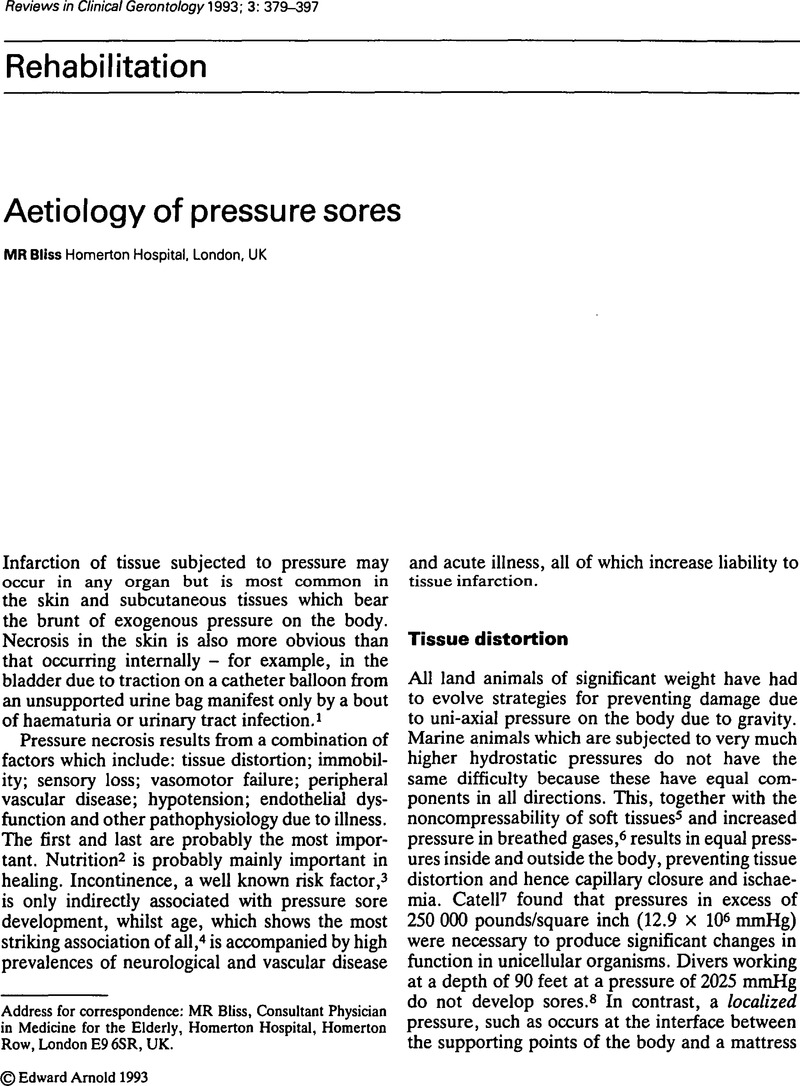Crossref Citations
This article has been cited by the following publications. This list is generated based on data provided by Crossref.
Hitch, Sally
1995.
NHS Executive Nursing Directorate - Strategy for major clinical guidelines - Prevention And Management of Pressure Sores.
Journal of Tissue Viability,
Vol. 5,
Issue. 1,
p.
3.
Rithalia, Shyam
1996.
Pressure Sores: Which Foam Mattress and Why?.
Journal of Tissue Viability,
Vol. 6,
Issue. 4,
p.
115.
Russell, Linda
1998.
Physiology of the skin and prevention of pressure sores.
British Journal of Nursing,
Vol. 7,
Issue. 18,
p.
1084.
Arblaster, Gillian M
1999.
Pressure sores: a preventable problem.
Nursing and Residential Care,
Vol. 1,
Issue. 2,
p.
100.
Collier, M.
1999.
Blanching and non-blanching hyperaemia.
Journal of Wound Care,
Vol. 8,
Issue. 2,
p.
63.
Gray, David
1999.
Pressure ulcer prevention and treatment: the Transair range.
British Journal of Nursing,
Vol. 8,
Issue. 7,
p.
1.
Gray, David
2000.
The new QUATTRO PLUSTM mattress replacement system.
Nursing and Residential Care,
Vol. 2,
Issue. 12,
p.
591.
Kenney, S. Rithalia, L.
2000.
Hospital bed mattresses: an overview of technical aspects.
Journal of Medical Engineering & Technology,
Vol. 24,
Issue. 1,
p.
32.
Land, Lucy
Evans, Debra
Geary, Amanda
and
Taylor, Carl
2000.
A clinical evaluation of an alternating-pressure mattress replacement system in hospital and residential care settings.
Journal of Tissue Viability,
Vol. 10,
Issue. 1,
p.
6.
Nixon, J.
Brown, J.
McElvenny, D.
Mason, S.
and
Bond, S.
2000.
Prognostic factors associated with pressure sore development in the immediate post-operative period.
International Journal of Nursing Studies,
Vol. 37,
Issue. 4,
p.
279.
Gray, David
2000.
The new QUATTRO PLUS™ mattress replacement system.
British Journal of Nursing,
Vol. 9,
Issue. 19,
p.
2100.
Defloor, Tom
and
Grypdonck, Maria H. F.
2000.
Do Pressure Relief Cushions Really Relieve Pressure?.
Western Journal of Nursing Research,
Vol. 22,
Issue. 3,
p.
335.
Scott, Eileen M.
Leaper, David J.
Clark, Michael
and
Kelly, Peter J.
2001.
Effects of Warming Therapy on Pressure Ulcers—a Randomized Trial.
AORN Journal,
Vol. 73,
Issue. 5,
p.
921.
2001.
A Difficult Wound to Treat?.
Journal of Wound Care,
Vol. 10,
Issue. 3,
p.
70.
Hampton, Sylvie
and
Collins, Fiona
2001.
SuperSkin: the management of skin susceptible to breakdown.
British Journal of Nursing,
Vol. 10,
Issue. 11,
p.
742.
O'Brien, Mark
and
Bennett, Gerry
2001.
Preventing pressure sores: a culture of responsibility.
Nursing and Residential Care,
Vol. 3,
Issue. 5,
p.
206.
Rice, Jan
2001.
Pressure ulcers: how do we reduce the incidence?.
Collegian,
Vol. 8,
Issue. 4,
p.
40.
Bosboom, E.M.H
Bouten, C.V.C
Oomens, C.W.J
van Straaten, H.W.M
Baaijens, F.P.T
and
Kuipers, H
2001.
Quantification and localisation of damage in rat muscles after controlled loading; a new approach to study the aetiology of pressure sores.
Medical Engineering & Physics,
Vol. 23,
Issue. 3,
p.
195.
Hughes, Caroline
2001.
Obstetric care. Is there risk of pressure damage after epidural anaesthesia?.
Journal of Tissue Viability,
Vol. 11,
Issue. 2,
p.
56.
Pritchard, Verna
2002.
The development of a birthing bed mattress.
British Journal of Midwifery,
Vol. 10,
Issue. 5,
p.
280.



